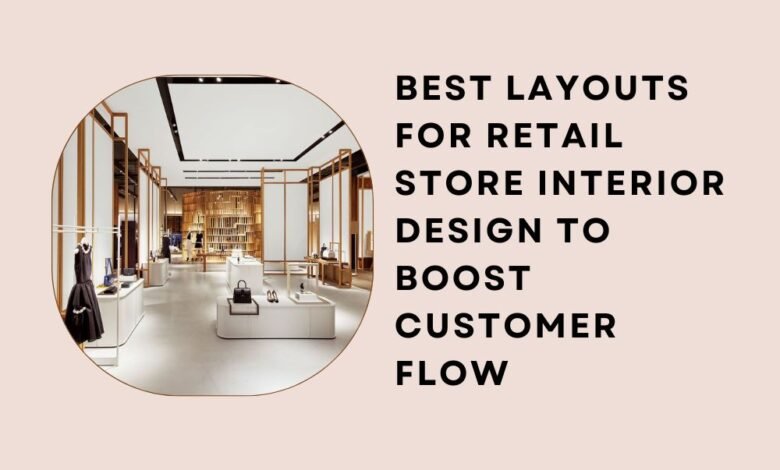Best Layouts for Retail Store Interior Design to Boost Customer Flow
Retail Store Interior Design

Designing an effective retail store layout is crucial for enhancing customer experience and boosting sales. An optimal layout not only makes it easier for customers to navigate through the store but also encourages them to spend more time exploring your products. In this guide, we’ll explore the best layouts for retail store interior design that can significantly improve customer flow and create a more inviting shopping environment.
Understanding Customer Flow in Retail Stores
The Importance of Customer Flow
Customer flow refers to how shoppers move through a retail store. Effective customer flow is essential because it influences the overall shopping experience. A well-designed layout guides customers naturally through different sections of the store, making it easier for them to find what they need. Additionally, good customer flow can increase the likelihood of impulse purchases, as shoppers are more likely to notice and buy items they might not have been actively looking for.
Note – For an exceptional transformation of your retail space, consider reaching out to ZXI Interior Decoration. With expertise in Retail Store Interior Design, their team can help create an inviting and efficient store layout that enhances customer flow and boosts sales. Discover how a professionally designed interior can elevate your retail environment—contact ZXI Interior Decoration today to get started on bringing your vision to life.
Analyzing Customer Behavior
Before diving into specific layouts, it’s important to understand how customers behave in a retail environment. Shoppers typically follow certain paths based on the store’s layout. For instance, they often start by browsing the front of the store and then move toward the back, checking out displays and products along the way. By analyzing customer behavior, you can design a layout that capitalizes on these natural tendencies, ensuring that high-margin or promotional items are placed in strategic locations to maximize visibility and sales.
Popular Retail Store Layouts

The Grid Layout
The grid layout is one of the most common and practical designs used in retail stores. It features a series of parallel aisles that are perpendicular to the store’s entrance. This layout is particularly effective for stores that carry a wide range of products, such as grocery stores or pharmacies.
Advantages of the Grid Layout:
- Ease of Navigation: Customers can easily navigate through the store by following the aisles, making it simple to find specific items.
- Maximizes Shelf Space: The grid layout allows for efficient use of wall and floor space, maximizing the display area for products.
- Cost-Effective: It is relatively inexpensive to implement and maintain, making it ideal for budget-conscious retailers.
Disadvantages of the Grid Layout:
- Less Engaging: The repetitive aisle structure can make the store feel monotonous, which might not be ideal for stores aiming to create a unique shopping experience.
- Limited Exploration: This layout may discourage customers from exploring areas outside of their intended path.
The Loop Layout
The loop layout, also known as the racetrack layout, is designed to lead customers in a circular path around the store. This design encourages shoppers to see more of the store’s offerings as they follow the loop from the entrance to the checkout.
Advantages of the Loop Layout:
- Increased Exposure: By guiding customers through a circular path, the loop layout ensures that they pass by various product categories and promotions.
- Encourages Browsing: The design encourages customers to explore different sections of the store, increasing the likelihood of impulse purchases.
- Enhanced Shopping Experience: The loop layout can create a more engaging and pleasant shopping experience, as it provides a clear path without sharp turns or dead ends.
Disadvantages of the Loop Layout:
- Complexity: Implementing a loop layout may be more complex and require more space than a grid layout.
- Potential Congestion: In high-traffic stores, the loop layout may lead to congestion, particularly at key points like the checkout area.
The Free-Flow Layout
The free-flow layout offers a more flexible and open design compared to grid or loop layouts. It features a less structured arrangement of merchandise and fixtures, allowing customers to move freely through the store.
Advantages of the Free-Flow Layout:
- Flexibility: This layout allows for frequent changes in product displays and store layout, which can keep the shopping experience fresh and engaging.
- Enhanced Exploration: The open design encourages customers to explore different areas of the store, leading to increased exposure to various products.
- Unique Atmosphere: The free-flow layout can create a more relaxed and inviting atmosphere, which is ideal for specialty stores or boutiques.
Disadvantages of the Free-Flow Layout:
- Navigation Challenges: Without clear aisles or pathways, customers might find it difficult to navigate, especially in larger stores.
- Space Utilization: The free-flow design may lead to less efficient use of space compared to more structured layouts.
The Boutique Layout
The boutique layout is often used in high-end retail stores and focuses on creating a unique and immersive shopping experience. This layout involves carefully curated displays and a more personalized approach to product presentation.
Advantages of the Boutique Layout:
- Enhanced Customer Experience: The boutique layout is designed to make shopping feel more like an experience, which can attract and retain customers.
- Showcase Luxury: This layout is ideal for showcasing high-end products and creating a luxurious atmosphere.
- Personal Touch: It allows for personalized displays and layouts that reflect the store’s brand identity and values.
Disadvantages of the Boutique Layout:
- Cost: Implementing a boutique layout can be more expensive due to the need for custom fixtures and decor.
- Limited Space: This layout may not be suitable for stores with large inventories, as it focuses more on presentation than on maximizing product display space.
Tips for Optimizing Retail Store Layouts
Use Signage Effectively
Clear and attractive signage is crucial for guiding customers through the store and highlighting key areas. Ensure that signs are easy to read and placed at strategic locations to direct shoppers to specific sections, promotions, or new arrivals.
Incorporate Interactive Elements
Interactive elements, such as digital displays or product demos, can enhance the shopping experience and encourage customers to spend more time in the store. These elements can also help highlight new or seasonal products, drawing attention and increasing sales.
Focus on Lighting
Lighting plays a significant role in retail store design. Use lighting strategically to highlight product displays and create an inviting atmosphere. Proper lighting can make products appear more appealing and draw customers’ attention to specific areas of the store.
Maintain a Clean and Organized Space
A clean and well-organized store is essential for creating a positive shopping experience. Ensure that aisles are clear of obstacles, products are neatly arranged, and the store is regularly cleaned. A tidy environment makes it easier for customers to find what they’re looking for and improves overall satisfaction.
Conclusion
Choosing the right layout for your retail store is a key factor in enhancing customer flow and improving the overall shopping experience. Whether you opt for a grid layout for its practicality, a loop layout for increased exposure, a free-flow layout for flexibility, or a boutique layout for a unique ambiance, each design has its own advantages and considerations. By understanding the strengths of each layout and implementing effective strategies, you can create a store environment that not only attracts customers but also encourages them to return.
For more insightful articles related to this topic, feel free to visit toastul.com



